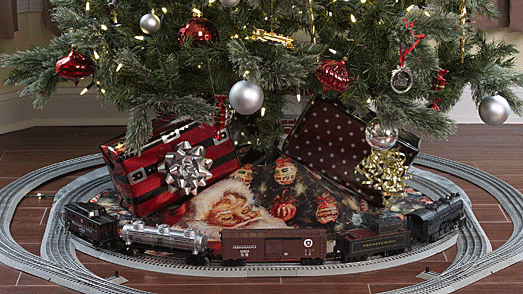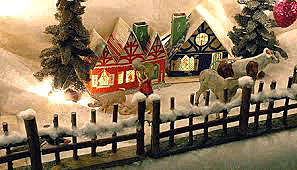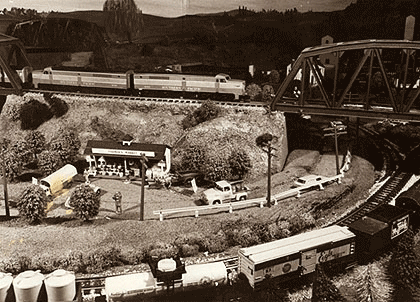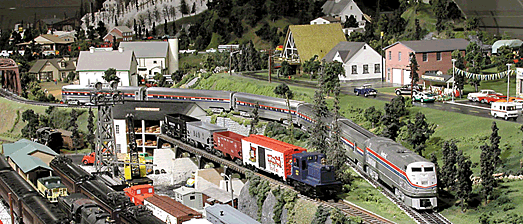I can remember when I
was a kid and the look of surprise on my face as I gazed up in
wonderment at the glimmering tree on Christmas morning. As my eyes
moved downward, they settled on a charming little "village" under
the tree, complete with houses, a church, a Nativity scene and a toy
train running around an oval track. I thought Santa brought all
this, when in fact, it was my parents who worked feverishly on
Christmas Eve after I went to bed to make my Christmas dream come
true.

Times have changed. Trees are no longer real, high-tech toys replace
blocks and Lincoln logs, as Christmas gets more and more commercial.
But one thing hasn't changed, my love of the magical world under the
Christmas tree.
The custom of building a village under the tree began with the
Moravians, who built a putz or Christmas tree yard under their
trees. The term was derived from the German verb putzen, to
decorate. No two were alike, but originally they all represented the
stable scene, complete with Mary and Joseph and the infant Jesus.

Preparations began in September, when each Moravian family would dig
up clumps of green moss and replant it in the cool, damp ground of
their cellar. A few days before Christmas, they'd carefully dig it
up again to use as the green grass of their putz. They also hunted
for old tree stumps, which they turned upside down and draped with
moss. The gnarled roots of the old tree, set inside a hill of dirt
and rocks, created an impression of a grotto for tiny figures of
shepherds and sheep to peer out of.
In addition to the stable there was frequently a winding sawdust or
sand road, which had to be long enough to accommodate as many as
three hundred small wooden animals proceeding two by two up the road
to Noah's Ark.
By the 1870's, tin soldiers and other secular toys had entered this
small world, the construction of which for many families became even
more time-consuming than the tree itself.
Separate areas under the tree were developed with different themes,
radiating out from the Nativity scene. Farms and villages became
more elaborate each year, since families had little else to do for
evening entertainment.
 Many
of these Christmas yards—the
first ones were surrounded by a white picket fence had snow- or
moss-covered hills which reached a height of three to five feet.
Some even had streams, cascading waterfalls, and lakes fed by
cisterns temporarily placed in the room above. Cranks, pulleys,
springs and water power drove a myriad of clockwork devices that
made sawmills work, gave the illusion of children playing on
seesaws, or sent a herd of livestock across a bridge.
Many
of these Christmas yards—the
first ones were surrounded by a white picket fence had snow- or
moss-covered hills which reached a height of three to five feet.
Some even had streams, cascading waterfalls, and lakes fed by
cisterns temporarily placed in the room above. Cranks, pulleys,
springs and water power drove a myriad of clockwork devices that
made sawmills work, gave the illusion of children playing on
seesaws, or sent a herd of livestock across a bridge.
 By
the 1890's, people could buy artificial moss or grass-green sawdust
by the bag, as well as tiny iron fences and trees. Cotton batting
and mica crystals represented snow and pieces of broken mirrors made
perfect ice-covered ponds. Soon, entire villages of printed
cardboard became available along with lead and plaster people.
By
the 1890's, people could buy artificial moss or grass-green sawdust
by the bag, as well as tiny iron fences and trees. Cotton batting
and mica crystals represented snow and pieces of broken mirrors made
perfect ice-covered ponds. Soon, entire villages of printed
cardboard became available along with lead and plaster people.
Time and the 20th century brought steel-spring wind-up trains and
alcohol-burning steam trains that ran around a track billowing puffs
of steam until the water in the boiler dissipated.
 Finally,
electric trains joined the wonderful miniature world in 1901, when
Joshua Lionel made his first ones. From that time on, toys that
fathers could give their sons and play with themselves joined the
simple manger scene as an integral part of the American holiday
season.
Finally,
electric trains joined the wonderful miniature world in 1901, when
Joshua Lionel made his first ones. From that time on, toys that
fathers could give their sons and play with themselves joined the
simple manger scene as an integral part of the American holiday
season.
Toy trains have long since been associated with the holiday season.
One of the best displays is at the
National Toy
Train Museum in Strasburg, Pennsylvania. Founded in 1954 by
the Train Collectors Association of Yardley, Pennsylvania, this
non-profit museum displays original examples of toy trains dating
from late 19th century to the present.
Nearby, the
Choo Choo
Barn, Traintown, USA, is a family hobby that got out of
hand. What started in 1945 as a single train chugging around the
Groff family Christmas tree is now a 1,700-square-foot fully
operating model train display featuring 16 Lionel trains and 140
animated scenes reproducing Lancaster County in miniature. Every
five minutes a house catches on fire and fire engines turn on their
hoses to extinguish the blaze. Flag bearers march in a Memorial Day
parade. And there's even a carnival and a three-ring circus.
Periodically, the overhead lights dim and streetlights glow and
locomotive headlights pierce the darkness.

But the granddaddy of them all is
Roadside America. Located off of I-78 in Shartlesville,
Pennsylvania, it's the largest indoor miniature village in the
country. In true Pennsylvania Dutch tradition, this putz takes in a
whole building and took over 60 years to build.
Roadside America is unique not only for its miniature hand-made
trains that roll through its countryside, but also for the variety
of miniature buildings, many of them exact models of Pennsylvania
landmarks. There's continual movement, as swift trains glide through
tunnels and over bridges past a tiny zoo, an old grist mill that
grinds flour, and downtown Fairfield, the make-believe town. It's so
big, it takes several hours to see it all.
Read more about the
National Train Museum.
